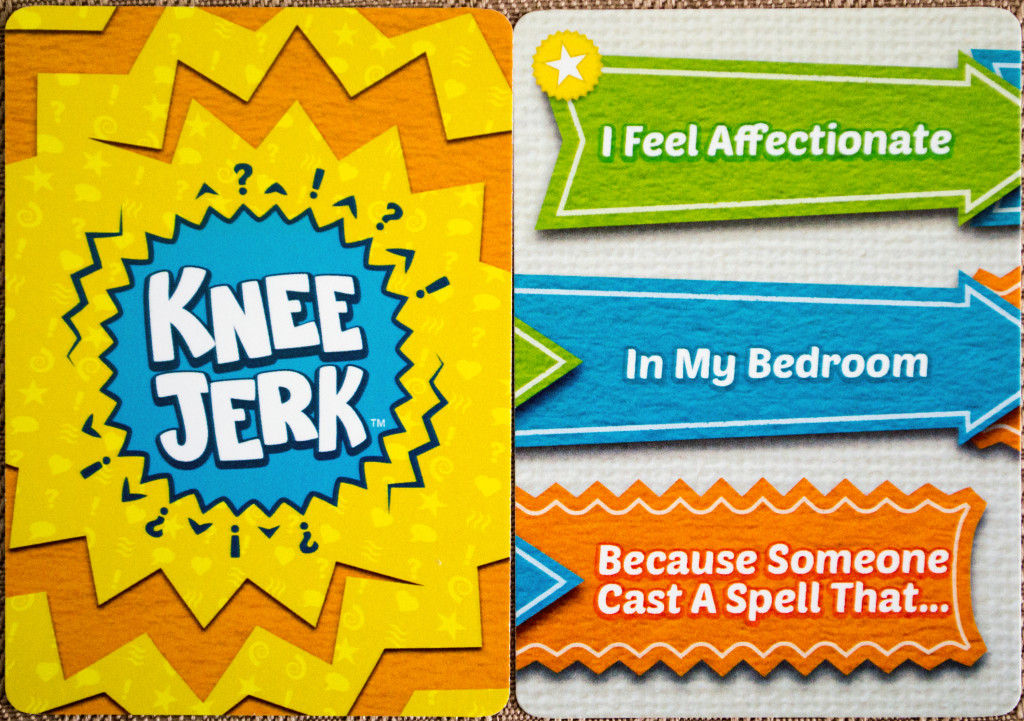Being the host of a party can be a lot of work, especially if your interests don’t jive well with everyone elses. For example, let’s say that you’re a respectable and hardworking dad who happens to love board games. It’s a stretch, I know…just bear with me. Imagine that you are having a huge family gathering at your place and need a few ways to keep everyone entertained. Most of them happen to be nongamers, so pulling “Agricola” or “Power Grid” out of your closet will probably be met by blank stares. At best, you’ll only succeed in entertaining the toddlers who have no qualms about throwing the pieces of your treasured games all over the place. “Knee Jerk”, a game that will be launching on Kickstarter on September 16, 2014, may very well be the solution. Before we get into the nitty-gritty details, I’d like to thank Game Creator Andrew Federspiel for reaching out and providing me with a prototype copy. It’s important to stress that prototypes are not often representative of the final product, making everything featured here subject to change.
The game is incredibly simple to play, mainly due to the fact that the only component you’ll have to deal with is a deck of cards. Each card contains three phrases, representing three different parts of your typical sentence. The first phrase of every card (with the green background) contains a personal pronoun (“I”), a verb, and an adjective. An example might be, “I feel panicked”. The second phrase of every card (with the blue background) contains a prepositional phrase like “at the beach”. The third phrase of every card (with the orange background) contains a phrase that will challenge the players to finish the sentence. An example of that might be, “because I saw…” or “because someone showed me…”. It’s worth noting that these cards connect to one another if placed side by side by matching the colored arrows appropriately. The first phrase of card “A”, for example, will line up with the second phrase of card “B”, which then in turn lines up with the third phrase of card “C”. This ensures that you’ll end up with a unique sentence almost every time.
At the beginning of the game, one player is designated as the host. Unlike other party games like “Apples to Apples”, this person will remain the host for the rest of the game. The host is like being the designated banker in “Monopoly” without ever playing…essentially you’re there to entertain and be the backbone for everyone else. To start the game off, the host will draw two cards from the deck to place face up on the table. The first phrase from the first card will line up with the second phrase from the second card. After that, the host will draw three cards to form their hand. The host will choose one card from their hand to place as the third card for that sentence, lining up the third phrase on that card with the second phrase of the second card. It may look funny (the cards won’t line up horizontally), but you should have an almost complete sentence like “I feel panicked at the beach because I saw…”.
At this point, players will race to call out an answer that resolves the sentence. The first person to do so, wins the first card (which serves as a point). In case of a tie, the host can choose whichever answer they like best. The host also has some leeway here…if the answer makes no sense, they can deny it outright. Once someone receives the first card as their point for the round, the second card on the table becomes the first and the third card on the table becomes the second. Once again, players will utilize the first phrase of the first card, followed by the second phrase of the second card, and so on. The host will draw a new card from the deck to replenish their hand back up to three cards and continue the process listed above until one player manages to score a set number of points. The value is different, depending on how many people are playing the game. The winner becomes the new host for the next game, should you desire to play again.
While I can’t in good conscience review a game that isn’t yet out on the market, I will say that “Knee Jerk” has a lot to offer. While the rulebook lists only one way to play, the game is very customizable and can be changed to suit your group’s needs. For example, instead of players racing to come up with an answer, they could instead each offer one anonymously by way of pencil and paper (similar to “Say Anything”). The host could then choose his/her favorite answer and via the honor system, the person who submitted that answer would announce that they scored. I’m sure there are other ways to go about playing, but you get the idea. I like the fact that it’s quick as a lot of the party games in my collection involve convoluted rules and/or a board of some type. When it comes to parties at my house, we have the most fun just sitting around in a group setting being silly and sarcastic. As such, “Knee Jerk” fills a void that some other games can’t and for that, it deserves your attention.
—
You can learn more about and support “Knee Jerk” by visiting its Kickstarter page, here:
https://www.kickstarter.com/projects/andrewfederspiel/knee-jerk-the-party-game-of-instant-reactions
—


